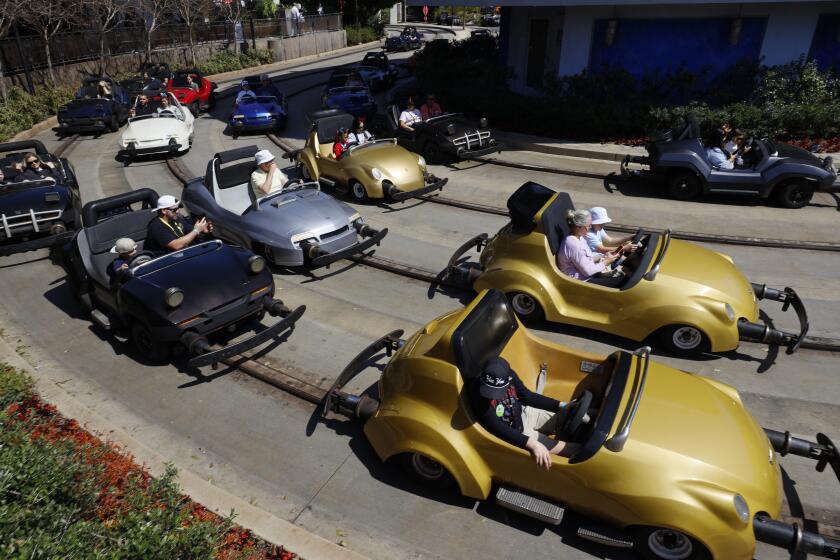Blue Line earns deadly reputation for suicides
Patricia Mayes was navigating a Red Line train into the Hollywood/Highland station when a young man climbed down from the subway platform and lay across the tracks.
In the split second before impact, they made eye contact. Then Mayes did as she had been trained.
“You pull the emergency brake, then turn your head away,” she said. “The train won’t stop in time.”
For more than a year, Mayes couldn’t bring herself to drive again. When she finally did, her face grew pale and her hands sweated and shook as she passed the station where the crash had occurred.
Such deaths on Los Angeles’ six light-rail lines, which average about 5 million monthly boardings, are relatively rare. But the Blue Line is the exception. The 22-mile line connecting downtown Los Angeles with Long Beach has long been considered the deadliest in Southern California. Since 1990, nearly 120 people have died along the line -- 31 by suicide -- more than all other lines combined.
In the last 15 months, the Blue Line has recorded seven suicides.
Mayes now works along the Blue Line, not as an operator, but as one of Metro’s 14 safety officers. She and others crisscross the Blue Line, looking for those who are trying to kill themselves or others who put their lives at risk by trying to beat the train at a crossing. It’s one of several steps the Los Angeles County Metropolitan Transportation Authority has taken to address Blue Line fatalities.
Metro has begun to ask the public to help prevent suicides, a rare move for transit organizations, which typically avoid the issue for fear of prompting copycat suicides. The agency has invested millions of dollars in gates intended to keep back cars and pedestrians at busy rail crossings, and signs with a suicide prevention hotline number were recently posted in every station. Coming into certain stations, operators have reduced their speed from 45 mph to 25 mph.
Accidental deaths have decreased this year, which officials say is a sign that the improvements have helped. But stopping people who want to kill themselves is more complicated.
“There’s only so much you can do, short of building a bubble around the line,” Metro spokesman Marc Littman said. “Even then, we suspect people would find a way.”
Five of the seven most recent suicide victims were men. They varied in age and race, and died at different stations. Some lay across the tracks or between the rails. Others jumped off a station platform as a train approached. One man stuck his head into a train’s path and was decapitated.
“There doesn’t seem to be any pattern,” Littman said.
The Blue Line’s tracks are entirely at ground level, and the line intersects roadways and walkways in more than 100 places. Metro says the train’s structure is not a factor.
Safety officers stationed at the 103rd Street/Watts Towers Blue Line station have stopped three suicide attempts this year. One employee, Theartis Blue, rescued a woman who stretched out on the tracks as the 8:36 a.m. southbound train approached. Blue picked her up and carried her to safety.
Experts say that it’s too soon to judge whether Blue Line suicides are more than a statistical fluke. Nationally, subway and light-rail suicides peaked in 2011, when 74 people killed themselves, according to federal data. That declined to 55 people in 2012, five of them in Los Angeles.
But the Los Angeles County Department of Mental Health said that although the most recent data on local suicides aren’t yet available, anecdotal evidence suggests the Blue Line matches a rising suicide rate countywide.
Psychologists say that the Blue Line’s suicides could be linked to the economy. The working-class area surrounding much of the Blue Line has seen high unemployment and mass home foreclosures.
“The economy has had an impact,” Department of Mental Health psychologist James Cunningham said, “and the fact that it’s starting to turn around doesn’t necessarily mean it’s reached a lot of folks.”
Even if bystanders recognize a suicide attempt, there’s seldom time to rescue someone. If a conductor notices, they are often too close to stop the train, which can weigh more than 150 tons.
“It’s a helpless thing, when you’re coming in at 55 mph and the train won’t stop on a dime,” said Roman Alarcon, a Metro supervisor. Nearly two decades ago, a man walked in front of his Blue Line train. He still finds it hard to discuss.
After a death, service typically stops for several hours as officials investigate, remove the body and clean the train.
Mayes, who Monday was stationed at a crossing in Willowbrook, said it’s hard to get those deaths out of her mind.
“When somebody kills themselves, more than just the family is affected,” she said. “Every death reminds you of what happened to you.”
Whenever she sees a passenger ignore the flashing red lights and ringing bells that signal an approaching train, she said, she thinks back several years to the suicide at Hollywood/Highland station. Then she says a prayer for the conductor.
--
More to Read
Start your day right
Sign up for Essential California for news, features and recommendations from the L.A. Times and beyond in your inbox six days a week.
You may occasionally receive promotional content from the Los Angeles Times.







